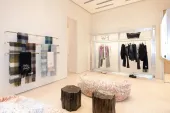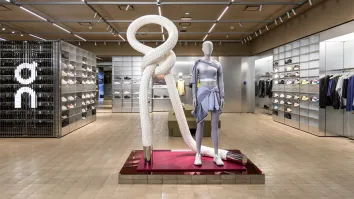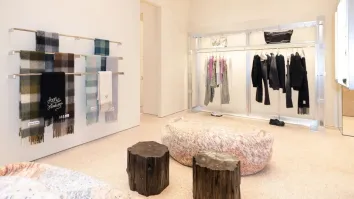Letting customers experience and live the brand
In modern retailing, store designs take on a primary role to attract customers and build brand loyalty, reportsTina Arceo-Dumlao.
You can’t exactly see it nor define it, but you can definitely feel its presence. Or absence, for that matter.
We are talking about the ambience of a retail outlet or mall that helps pull in customers who are spoilt for choice, especially in the Philippines where foreign brands are coming in droves to take advantage of robust economic growth.
To pin down that elusive ambience appropriate for a brand’s positioning in the crowded marketplace is the function of a store’s design, which is why brands invest not a modest amount in its development and implementation.
Indeed, the right design, aside from pricing and product mix, can spell the difference between a found and a lost sale in the ever-widening sea of options available to flighty customers.
The importance of design is not lost on Regatta, a casual wear brand with 31 stores that is preparing to plant the Philippine flag on foreign shores as part of its global expansion programme.
According to Alice Liu, vice-president for Fashion Retail of Golden ABC Inc., which owns the Regatta brand, store design is part of the brand DNA of Regatta, which is positioning itself as a “timeless leisure wear brand for unpretentious buyers”.
Regatta partnered with a foreign design team to highlight the elements most representative of the brand, including the signage, and generous use of the two oars since the name Regatta evokes images of the genteel crowd enjoying the great outdoors.
“We provided little, important details to remind customers of what Regatta is all about and we did not spare any cost to getting the look just right.”
Liu says there are a number of elements that combine to make a modern and exciting retail store.The store façade should be exciting and inviting for customers to consider going inside the store.
The signage and show windows should attract customers since these are the first visible representations of the brand and the merchandise.
Store ambience brought about by the lighting, sound, scent, technology and store layout must invite customers to linger and check out the brand’s various offerings.
Products should be displayed in a way that will not take a lot of effort for the customers to find what they need.
And for the look to work, Liu says, it must be complemented by the experience that one gets from the service provided by the staff.
“Though store design is important in making the store exciting, the merchandise should still be the hero and the store design just enhances the merchandise and the overall shopping experience,” Liu stresses.
A brand’s look and feel does not remain static. Similar to how clothing designs and accessories evolve through the seasons, so does the store design.
Regatta’s initial look was inspired by the country club lifestyle. Through the years, the design evolved from just being inspired by the sea to one that addresses a wider range of customers and tastes, thus the current “town and country and sea and coast” look that incorporates two distinct but intertwined lifestyles, and the use of bleached wood and light colours so as not to jar the senses.
“Regatta’s store design wants to convey a laid back feel without being too staid. It makes one imagine being in the country or seaside which conveys a sense of being free-spirited and confident,” shares Liu. “We want our customers to smile and feel relaxed when they enter the store as we welcome them to the Regatta World, away from the hustle and bustle of the daily grind. Regatta is the leisure wear that stands for relaxed lifestyle.”
Liu cannot stress enough the value of having a standout store design, especially now when more retail competition is anticipated. With the integration of the economies of the Association of Southeast Asian Nations in 2015, brands across the region will find it easier to compete across borders. A distinctive store design is seen to go a long way in helping to ensure brand recall as well as loyalty among customers.
“The store is where customers experience and live the brand. It can be the most effective marketing tool of any brand. In one look, the store can convey to the customers its brand identity. Thus, we have to make sure that the store is both effective and efficient, meaning it is aesthetically welcoming and the various touch points in the store enhances the shopping experience,” Liu says.
The 25-year-old Cravings restaurant group has likewise invested in perfecting the look and feel of its newest offering called Epicurious, a gourmet deli and casual dining restaurant in Shangrila Plaza Mall in Mandaluyong City.
According to Issa Rodriguez, corporate marketing director of the Cravings Group, the aesthetics of Epicurious were inspired by the gourmet halls, food emporiums and markets visited around the world by the group’s owners, whose love for food led to their investing in a chain of restaurants.
The core insight, Rodriguez says, was that food is an adventure and an experience in itself and that there are customers looking for an opportunity to indulge in their desire to have a direct hand in how they want their food done and the ingredients to be included in their perfect dish.
“Epicurious is centred on the diners. We want to offer them the freedom to create their own culinary delight. That is our brand promise,” says Rodriguez in an interview.
To execute that brand promise, Epicurious is designed with the food offerings as the main attractions, thus the breads at the entrance and the refrigerated display cabinets dominating the hall. These feature a carefully curated selection of meats, pasta sauces, herbs, salad greens, dressings.
Chillers on the side, meanwhile, feature a selection of beverages while towards the back of the restaurant and deli are displays of bottled sauces and food products as well as pasta and small kitchen appliances and utensils for those who prefer to cook and entertain guests at home.
There is also an open kitchen where in-house chefs – most of whom are associated with the Cravings group – can execute the food order. Quaint tables and chairs are also available for dine-in guests although many clients also prefer to just take out their purchases.
For Rodriguez, the welcoming feel of Epicurious helps initiate Filipinos to a new kind of dining experience, where they can have their own culinary masterpiece from the products on display.
“Epicurious seeks to be the neighbourhood restaurant, catering to everybody from the very young to the not-so-young. What we are trying to offer is gourmet convenience, a mix of shopping and dining, indeed a whole new lifestyle experience,” says Rodriguez.“That is why it is called Epicurious, a place to explore and discover where food is the main item.”
Epicurious opened on 15 December 2013, and Rodriguez says the concept has picked up quickly among customers and the seats are being filled through word-of-mouth advertising. A reason for its popularity is the selection of products, which are a mix of local and imported, and the other is the comfort afforded by the layout and the design of Epicurious.
Despite it being a new and as yet unfamiliar concept, Filipinos are encouraged to actually go through its doors thanks to the homey design that invites people to come in and stay a while.
Indeed, while store design may not be everything to a store, it is a major factor that can make – or break – a retail enterprise.



















 Advertise
Advertise







